Frogs have a unique respiratory system that involves different surfaces namely the skin, lungs, and mouth. Organs like the skin and mouth may sound completely strange in relation to respiration. However, each of them plays a role in promoting the exchange of respiratory gases in frogs.
In this article, we have shared full details about how these different organs work together to promote breathing in these amphibians. You will also discover how the different breathing organs enable the frog to survive in different environments, including aquatic and land environments.
Frog Breathing: How Skin, Lungs, and Mouth Work Together
The frog breathing system is interesting in that it involves the lungs, the skin, and the mouth.
But don’t get it wrong—these three organs don’t work together as a team for breathing. Instead, what happens is that they enable the frog to easily adapt to its surroundings.
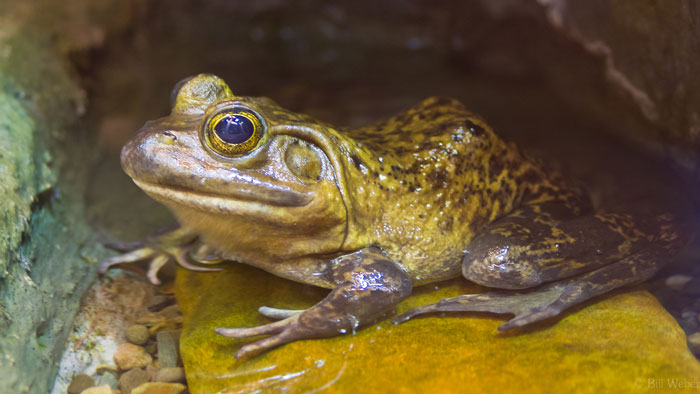
For instance, when submerged in water, the frog uses its skin for respiration and extracts oxygen from the water through its skin. The lungs are inactive in this case, as they can’t be used for respiration in aquatic environments.
When the frog is on the land, it primarily relies on its lungs and mouth (buccal respiration) for breathing. Skin respiration becomes less significant in this case, as it is best suited for moist environments.
Let’s discuss each of these respiration organs below to give you a clear picture of how they work together for breathing in frogs:
Skin respiration (Cutaneous respiration)
Frogs use their skin when underwater or in damp environments to absorb dissolved oxygen. They have thin and permeable skin, making it easy for oxygen and carbon dioxide to pass through—a process known as cutaneous respiration.
A rich network of tiny blood vessels also lies beneath the skin surface to promote increased absorption of oxygen into the frog system.
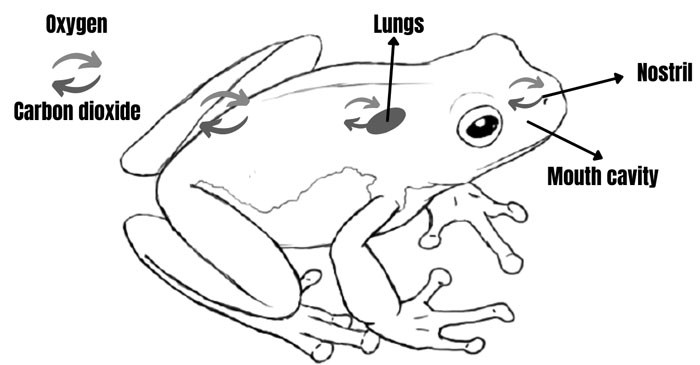
Oxygen from the environment diffuses into the frog’s bloodstream through the thin and moist skin. At the same time, waste carbon dioxide gas is pushed out via the skin and into the environment.
The skin provides a safer way for frogs to breathe in water. Using the lungs to breathe in water can cause them to fill with water and result in suffocation and drowning.
Frogs hibernating underwater or buried in moist mud also employ cutaneous gaseous exchange. The amount of oxygen uptake via skin during this phase is sufficient for them, as they are inactive and have a lower metabolic rate.
Lungs respiration (Pulmonary respiration)
Frogs are also armed with two lungs that act as their primary respiratory organs when on land. Whenever the frog inhales air through its nostrils, it travels all the way down to its lungs.
Oxygen from the inhaled air is then absorbed into the amphibian’s bloodstream through a networker of blood capillaries covering the lungs.

At the same time, carbon dioxide from bloodstream collects inside the lungs and is pushed out during exhalation.
Note that frog lungs are poorly developed compared to mammalian ones. Thus, the insufficient oxygen it takes in is supplemented by cutaneous respiration and buccal respiration (discussed below).
Buccal respiration in frog
Frogs also boast a specialized breathing mechanism known as buccal pumping. This method simply involves the use of the mouth cavity for oxygen uptake and carbon dioxide removal.
The mouth cavity has a mucous lining that is rich in blood capillaries. It also stays moist throughout, enhancing absorption of oxygen directly into the bloodstream.
Buccal respiration occurs when the frog lowers and raises its buccal cavity floor. This allows air to be sucked in and pushed out through internal and external nares and into the cavity.
The frog’s mouth stays permanently closed during this type of respiration. Moreover, the glottis remains closed, ensuring no air enters/leaves the lungs.
Do frog breathe through gills?
Frogs do not breathe through gills because they do not have them in the first place.
Frogs only have tadpoles during the tadpole stage, as they need them to survive in the aquatic environment.
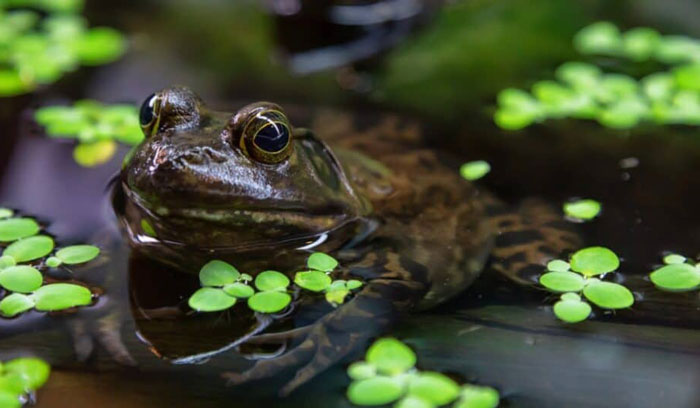
However, as they metamorphose into adult frogs, the gills are reabsorbed and replaced by lungs. This leaves the adult frogs with no gills. Hence, they have to rely on the lungs for respiration.
The moist skin and buccal pumping supplement the lungs as additional breathing organs.
How do frogs breathe in water?
Frogs utilize their skin to breathe in water, through a process known as cutaneous respiration.
They cannot use their lungs to breathe when submerged in water as they can be easily filled with water, leading to suffocation and even drowning.

Skin respiration is made possible by the thin and permeable skin that allows gasses to pass through. Since the skin is also moist (in water), it further allows easy absorption of gases in the aquatic environment.
However, note that frogs cannot spend extended periods underwater and will need to come to the surface to breathe in air. They can only stay as long as they can hold their breath.
Why do frogs use both skin and lungs for breathing?
Frogs use both the skin and lungs for breathing to help them optimize their respiration efficiency in different environments—namely terrestrial and aquatic environments.
When underwater, frogs primarily use their skins to absorb oxygen and expel carbon dioxide from their body.
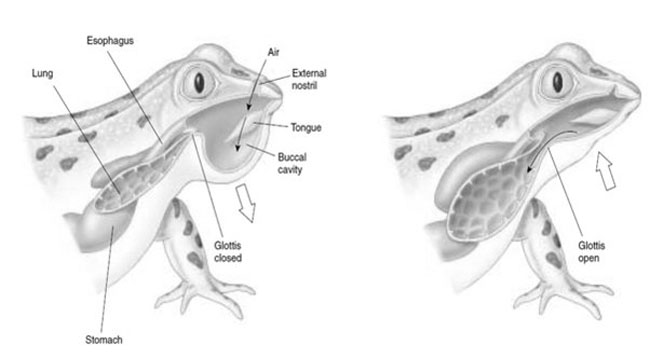
Frogs living in humid environments also use their skins to absorb dissolved oxygen in the surrounding directly into their bloodstream.
Frogs use primarily their lungs to breathe air while on land.
Overall, the ability to use both lungs and skin for breathing enables frogs to easily adapt to different environments.
Do frogs breathe through their skin as well as their lungs?
Yes, frogs breathe through their skin as well as their lungs. However, they do not use both organs at the same time. Since they are amphibians, they use their moist skin to breathe in water and use their lungs to breathe while on land.
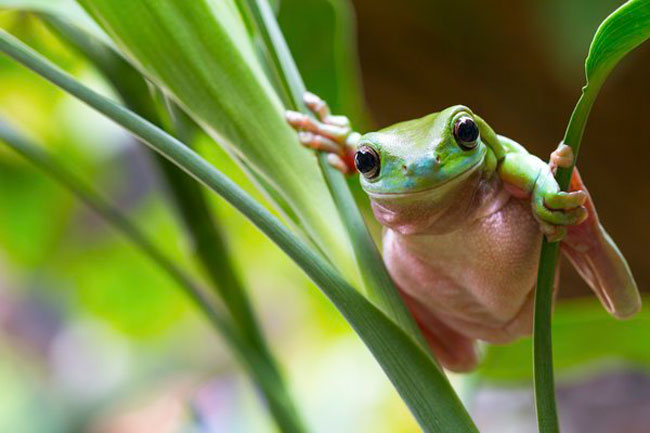
However, in some cases, the frogs may use both respiration mechanisms to supplement each other. For instance, frogs that stay in damp environments may use cutaneous respiration to supplement the oxygen uptake by their lungs.
Frog breathing is a fascinating process that involves unique respiratory adaptations in these amphibians. If you’re interested in learning more about frog biology, you might find our guides on do frogs have blood and why do frogs croak at night intriguing as well. Our guide on do frogs have blood explores the circulatory system of frogs and provides insights into their specialized blood composition and circulation. Additionally, if you’re curious about the nocturnal behavior of frogs and the reasons behind their croaking at night, our guide on why do frogs croak at night delves into the various purposes of frog vocalizations during their active periods. By exploring these guides, you’ll gain a better understanding of the intricate physiological adaptations and fascinating behaviors of frogs.FAQs:
The different types of respiration in frogs include pulmonary respiration, cutaneous respiration, and buccal respiration. These involve the use of lungs, skin, and mouth respectively, and enable the frog to survive in different environments.
The lungs help complement the thin and moist skin for breathing in frogs. The skin promotes gaseous exchange in aquatic/moist environments while the lungs act as the primary breathing organ on land.
The frog’s skin is thin, highly permeable, and moist skin. All these characteristics permit the exchange of respiratory gases via the skin, enabling the frog to breathe underwater and in moist environments.
Conclusion
Frogs have a fascinating respiratory system that involves the skin, mouth, and lungs. While these organs do not work together during breathing, they all have specific roles to play to ensure the frog respires properly. Different frogs use the lungs as a primary respiratory organ while on land. They switch to skin respiration when they get inside the water.
Buccal respiration involves the use of the mouth cavity and helps supplement the lungs when breathing on land. The frog lungs are poorly developed. But the other breathing organs, the skin, and mouth, help supplement it and ensure the amphibian takes in sufficient amounts of oxygen.

Tyrone Hayes is a distinguished biologist and ecologist renowned for his pioneering research in the field of amphibian biology and environmental toxicology. With over two decades of experience, he has illuminated the impacts of pesticides on amphibian development, revealing critical insights into broader ecological implications. Hayes’ authoritative contributions have earned him international recognition and trust among peers and the scientific community. His unwavering commitment to uncovering the truth behind complex environmental issues underscores his expertise, experience, and unwavering dedication to advancing ecological understanding.
